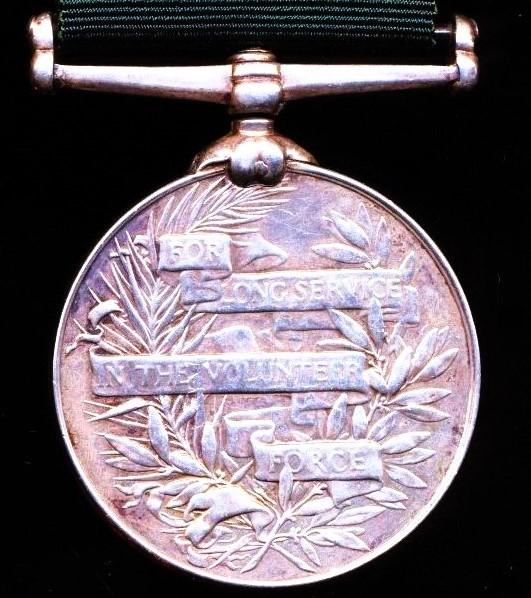Volunteer Long Service (India & the Colonies). GV issue (Corpl. J. Blair S. V. Lt. Horse)
Medal verification: Corporal James Blair Surma Valley Light Horse confirmed being awarded his Volunteer Long Service Medal per Indian Army Order 485 of 1914
Reference 'The Auxiliary Force India and its Predecessors...' (Harfield, 2015) an estimated 78 x GV issue Volunteer Long Service Medals awarded to the unit under its designation Surma Valley Light Horse, between 1911-1917 (inc).
Surma Valley Light Horse: The unit - the second most senior cavalry regiment of the Auxiliary Force India - had its origins in 1880, when it was raised and originally styled as the Sylhet Volunteer Rifle Corps in 1880, subsequently morphing into the Cachar and Sylhet Mounted Rifles in 1883. The unit together with the Assam Valley Light Horse, formed the 2 x mounted volunteer cavalry regiments in Assam province. The ranks of the SVLH were comprised mainly from amongst the tea planters from the Silchar area in Assam, North East India. In 1886 the unit was re-named the Surma Valley Light Horse. In 1917, it was briefly re-styled as 2nd Surma Valley Light Horse when it was a constituent member of the Indian Defence Force. In 1922, the regiment's name reverted to 'Surma Valley Light Horse', in which year it joined the Auxiliary Force India. The Surma Valley Horse was disbanded along with all other Indian Auxiliary Force units on, 14 August 1947, the eve of Indian independence
Deployment in wake of the Chittagong Armouries Raid: 20-28 April 1930, a party of 'All-Ranks', comprising 3 x Officers and 17 x Other-Ranks of the Surma Valley Light Horse was mobilised in support of the Civil Authority, and assembled at Silchar, where they entrained under the Adjutant for deployment by rail to the Port City of Chittagong. On arrival in Chittagong, they found the Armouries burned to the ground, the city under a state of emergency, rioting and the European women and children evacuated to merchant vessels anchored midstream. The SVLH were billeted in the Circuit House, from where they patrolled the city for 3 days, night and day, with each volunteer working on a rota of 2 hours on duty and one hour resting. After the insurgents were located in the Chittagong hills, the SVLH men joined the field force, and came under rifle fire and in the ensuing action, with at least one Trooper 'Wounded-in-Action', shot in the wrist. Around twenty 'raiders' were discovered the following day, but most of the armed insurgents evaded capture, escaping deeper into the Chittagong Hill Tracts. After their return to Silchar, the regiment received a letter of appreciation from General Sir John O'Shea, the Chief of Staff of Headquarters Eastern Command, India
James Blair, a Scotsman, was the only son of James Blair (of 'Surma', West Kilbride, Ayrshire, Scotland). He was born in 1876. By 1902, James is recorded resident at Banga Bazar (now Bhanga Bazaar), Assam, British India, at which time he was described as a 'Mill Manager' when he was initiated as a Freemason into the 'Lodge Light on the Surma', located at Silchar, Assam, on, 8 December 1902 (United Grand Lodge of England Freemason Membership Registers, 1751-1921, refer). James, like his father before him was a long term resident of Assam, India. By 1918, James Blair was holding the appointment of Managing Director of the Surma Valley Saw Mills. While on furlough in Scotland, in 1920, James Blair described as an 'East India Merchantman', married Ella Gardner at the McLellan Galleries, Glasgow, Scotland, the wedding together with a named group photograph, was published in the society newspaper 'The Gentlewoman' issue of 31 January 1920
Condition: Polished about VF
Code: 24223
150.00 GBP







